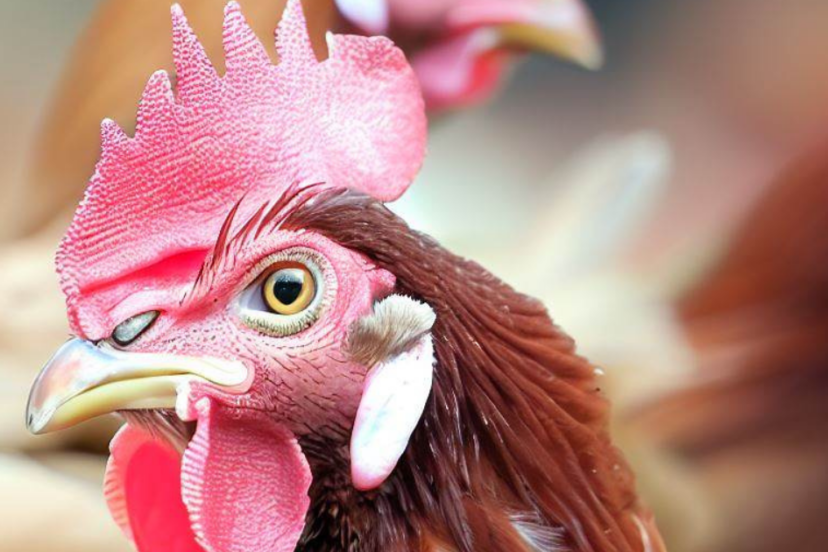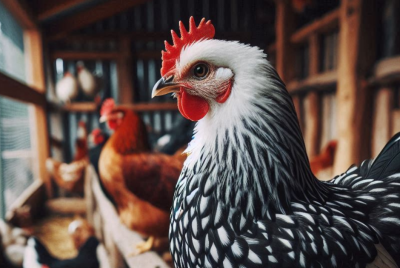Brown Leghorn chickens have captured the hearts of chicken enthusiasts worldwide. Their striking appearance, lively demeanor, and exceptional egg-laying capabilities make them a favorite among poultry keepers. In this article, we will delve into the world of brown leghorns, exploring their characteristics, benefits, housing requirements, and providing valuable tips for successful rearing.
Origins
The Leghorn breed was developed in Livorno, Italy (formerly known as Leghorn in English), and was first imported to the United States in the 1820s. The breed gained popularity in both Europe and America due to its exceptional egg production and hardiness.
Brown Leghorn Chickens are popular not only for their egg-laying prowess but also for their attractive appearance and lively personalities. They are a beloved breed among poultry enthusiasts and continue to make a significant contribution to the egg industry.
Characteristics of the Brown Leghorn Chicken
Appearance and Physical Features
The brown leghorn chicken boasts an elegant appearance with its slender build, upright stance, and glossy feathers. Their plumage exhibits shades of rich brown with distinct white speckles, creating a beautiful contrast. With their bright red combs and wattles, they add a vibrant touch to any flock.
Temperament and Behavior
Known for their energetic nature, brown leghorns are active foragers and avid explorers. They possess a curious and independent personality, making them a joy to observe. These chickens are generally friendly and adaptable, but they may exhibit a slightly skittish behavior compared to other breeds.
Egg-laying Capabilities
One of the primary reasons chicken keepers are drawn to brown leghorns is their exceptional egg-laying abilities. These diligent layers can produce an impressive number of large, brown eggs. On average, a brown leghorn chicken can lay up to 280-320 eggs per year, making them a reliable source of fresh eggs for your family.
Benefits of Raising Brown Leghorn Chickens
High Egg Production and Consistency
If you’re looking for a breed that can provide a steady supply of eggs, brown leghorns are an excellent choice. Their consistent egg-laying performance ensures a bountiful harvest throughout the year. With their exceptional productivity, you’ll have plenty of eggs for your breakfast table and even some extras to share with friends and neighbors.
Adaptability to Different Climates
Brown leghorn chickens exhibit remarkable adaptability to various climates. Whether you live in a hot, cold, or temperate region, these hardy birds can thrive and continue laying eggs consistently. Their adaptability makes them suitable for backyard farming across different geographical locations.
Low Maintenance and Self-sufficiency
For those seeking low-maintenance poultry, brown leghorns fit the bill. They are resourceful foragers and have a keen ability to find food on their own. While providing a balanced diet is essential, these chickens can supplement their diet with insects, weeds, and kitchen scraps, reducing feed costs and promoting self-sufficiency.
Housing and Care for Brown Leghorn Chickens
Coop Requirements and Space Considerations
When it comes to housing brown leghorns, providing a secure and comfortable coop is vital. Ensure sufficient space per chicken, allowing at least 4 square feet of coop space per bird. A well-ventilated and predator-proof coop with proper nesting boxes and roosting perches is essential for their well-being.
Feeding and Nutritional Needs
To support their high egg production, brown leghorns require a nutritious diet. A balanced layer feed supplemented with fresh fruits, vegetables, and occasional treats like mealworms or scratch grains will keep them healthy and content. Providing clean water at all times is crucial to their well-being.
Health Care and Disease Prevention
Maintaining good health in your flock is paramount. Regularly inspect your chickens for signs of illness, practice proper biosecurity measures, and provide necessary vaccinations. Clean the coop regularly to prevent the buildup of bacteria and parasites that could jeopardize their health.
Tips for Successful Brown Leghorn Chicken Rearing
Selecting Healthy Chicks or Hens
When acquiring brown leghorns, choose healthy chicks or hens from reputable breeders or hatcheries. Look for birds with bright eyes, clean feathers, and alert behavior. Healthy birds have a strong immune system and are more likely to thrive in your care.
Providing Adequate Shelter and Protection
Ensure your brown leghorns have a secure and predator-proof coop. Use sturdy fencing to create a safe outdoor area where they can roam and forage. Protect them from extreme weather conditions by providing shade in hot climates and insulation during colder months.
Socialization and Enrichment
Brown leghorns are social creatures and benefit from interaction with their flockmates. Introduce them to other friendly chickens to foster a sense of companionship and reduce stress. Additionally, provide environmental enrichment such as perches, dust baths, and toys to keep them mentally stimulated.
Regular Monitoring and Observation
Monitor your brown leghorns regularly to detect any signs of illness or distress. Observe their behavior, appetite, and egg production patterns. Early detection of health issues allows for prompt intervention and better chances of successful treatment.
Egg Collection and Storage
Collect eggs from the nesting boxes regularly to maintain their freshness. Store eggs in a cool, dry place with proper ventilation. Avoid washing eggs unless necessary, as this removes the protective natural bloom that helps preserve their quality.
Egg-citing Egg Facts
Please note that egg production can vary based on various factors, including genetics, diet, care, and environmental conditions. These fun facts are a general representation and individual chickens within each breed may have some variations in egg-laying performance.
1. White Leghorn:
Eggs : The White Leghorn holds the title for the highest egg production among chicken breeds. They are prolific layers, known for their exceptional egg-laying abilities and can produce around 280 to 320 white eggs per year.
Active and flighty: Leghorns are known for their active and agile nature. They are excellent flyers and prefer to perch in higher places.
2. Brown Leghorn:
Eggs: Brown Leghorns are excellent layers, often considered close contenders to their white counterparts. They can lay a similar number of eggs as White Leghorns, with around 280 to 320 brown eggs per year.
Energetic and curious: Like White Leghorns, Brown Leghorns are active and curious birds. They are always on the move, exploring their environment and scratching for food.
Independent: Leghorns are relatively independent birds and can be more aloof compared to other breeds. They enjoy free-ranging and exploring their surroundings.
3. Rhode Island Red:
Eggs: Rhode Island Reds are renowned for their reliable and consistent egg production. They lay approximately 200 to 300 brown eggs per year and are known for their hardiness and versatility.
Broodiness: While Rhode Island Reds are known for their excellent egg-laying, they have a tendency to go broody occasionally. This means they may exhibit a desire to sit on eggs and hatch them, temporarily stopping their egg production.
4. Sussex:
Eggs: Sussex chickens are known for their dual-purpose qualities, excelling in both meat and egg production. They are dependable layers, producing around 250 to 280 brown eggs per year.
Docile and friendly: Sussex chickens are generally known for their calm and friendly disposition. They can be more docile compared to some other breeds, making them a popular choice for backyard flocks and families.
5. Plymouth Rock (Barred Rock):
Eggs: Plymouth Rock chickens are popular for their well-rounded attributes, including their egg-laying capabilities. They lay approximately 200 to 280 brown eggs per year, making them a reliable choice for backyard flocks.
Cold hardiness: Barred Rocks, including the Plymouth Rock breed, are known for their cold hardiness. They can tolerate colder temperatures well, making them suitable for various climates.
Conclusion
Brown Leghorn chickens are a delightful addition to any backyard flock, offering beautiful plumage, vibrant personalities, and prolific egg-laying abilities. By providing them with the right care, housing, and nutrition, you can enjoy a consistent supply of fresh eggs and the pleasure of their company. Embrace the joys of raising brown leghorns and witness the wonders of these remarkable feathered friends.
FAQs
1. Can brown leghorns coexist with other chicken breeds in the same coop?
Yes, brown leghorns generally get along well with other chicken breeds. Proper introductions and adequate space in the coop will help promote peaceful coexistence.
2. Do brown leghorns require supplemental lighting to maintain egg production during shorter daylight hours?
Yes providing supplemental lighting during shorter daylight periods can help sustain consistent egg production.
3. Are brown leghorns suitable for free-ranging in a backyard garden?
While brown leghorns enjoy foraging, they may be more inclined to scratch and peck in garden beds. Consider using fencing or other measures to protect your garden if you choose to let them free-range.
4. What is the lifespan of a brown leghorn chicken?
On average, brown leghorns can live up to 6-8 years with proper care, although individual lifespan may vary.
5. Can brown leghorns be kept in urban areas with noise and limited space?
Yes, brown leghorns can adapt well to urban environments. However, consider the noise levels and space restrictions to ensure their well-being and compliance with local regulations.
*We may earn a commission from purchases made through our links, at no cost to you. This does not affect our product recommendations. Please see our disclosure to learn more.




